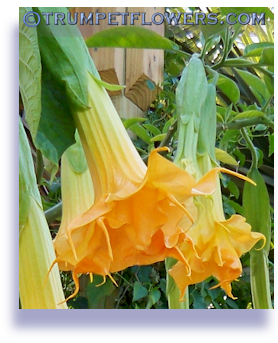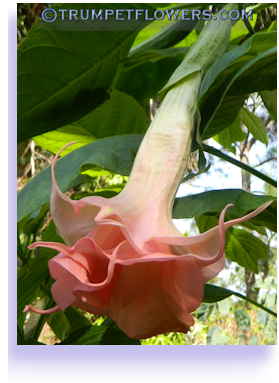Egg Versus Rooting
Hormone
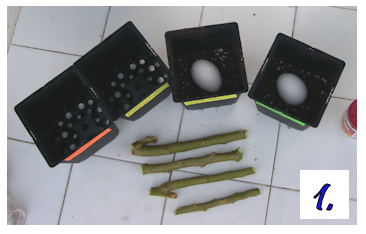 I guess we are always trying to find a better way to get those hard to root cuttings to take. I'm going to forego a method often used for Plumeria cuttings in this experiment. The cultivar I am using is Brugmansia, Ecuador Pink.
I guess we are always trying to find a better way to get those hard to root cuttings to take. I'm going to forego a method often used for Plumeria cuttings in this experiment. The cultivar I am using is Brugmansia, Ecuador Pink.
This experiment was started December 27th, 2011. I took 4 mostly equally sized angel trumpets vegetative growth cuttings and dipped each one in distilled water that had Actinovate added to it to curtail fungus.
I then prepared each of them as follows:
- No. 1: Take Root brand Rooting Hormone Powder
- No. 2: Nothing added, the control.
- No. 3: Take Root brand Rooting Hormone & a Fresh Large Chicken Egg
- No. 4: Large Chicken egg only
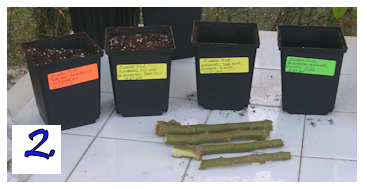 To all, my own soiless mixture was used, which is composed of compost, peat and perlite, etc. The eggs cutting pots were prepared by first placing approximately 2 inches of soil in the bottom of each container, and then the egg, and enough soil to cover the egg. (Fig. 1) Then I carefully suspended the cutting, touching soil now but very close to the egg, and then filled in with more soil to the top of planter. I firmed the soil by lightly pressing it. All were then given a bit of distilled water to settle into the pots. Placed in partial sun with about 3 hours good weak afternoon sun.
To all, my own soiless mixture was used, which is composed of compost, peat and perlite, etc. The eggs cutting pots were prepared by first placing approximately 2 inches of soil in the bottom of each container, and then the egg, and enough soil to cover the egg. (Fig. 1) Then I carefully suspended the cutting, touching soil now but very close to the egg, and then filled in with more soil to the top of planter. I firmed the soil by lightly pressing it. All were then given a bit of distilled water to settle into the pots. Placed in partial sun with about 3 hours good weak afternoon sun.
All four pots were first labelled up with the appropriate values set to each. I will uproot every cutting in early April 2012 and post photos of any growth activity. Pots are in a screened in space, exposed to weather other than the screen.
If you'd like to try this (or the results) yourself, and don't know how to properly prepare a set of cuttings, please refer to taking cuttings here.
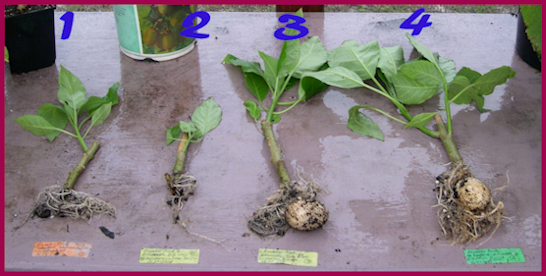
So, here come the results. It is April, 2012, and I have turned out every pot and rinsed the roots so you can see how each cutting has come along.
One thing I did notice right away. I thought the cutting that had been dipped in the rooting hormone powder and given an egg, would have done better. But the best cutting of all, was the one that had only the egg used as a rooting agent.
Since the good side of this experiment can be seen, and so no explanation is really needed, all I will add is the cons and other observations.
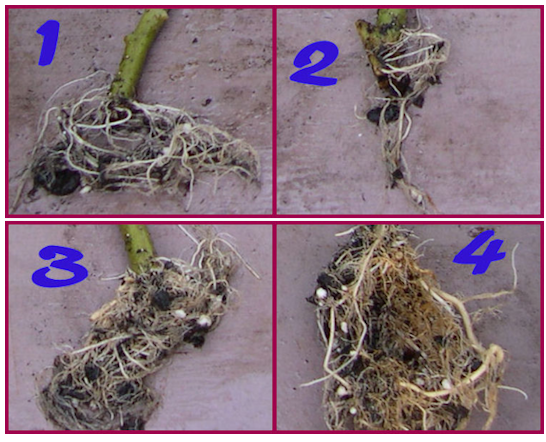
The eggs remained intact, although from picking each one up, I could tell there was still 'goo' in the centers, but it had been greatly reduced in mass. I burst one of the eggs, and the smell was horrendous! Another thing that must be noted is that the egg will of course, create a hollow space in the surrounding soil. You must be sure to pack this tight with new soil when gently removing the egg and repotting the new rooted cutting.
I have heard it said that it is the gases that the egg releases that interact with the cutting, stimulating it to create roots faster. I do not know if this is true. I do know that the egg rooting method worked very well.
Bury the spent eggs. I threw one or two way out into the property, (thinking if it was good for the plants, why not?) and the breeze would throw the nasty smell my way for almost a week afterward. It also drew in bugs to that area. A no no. Just dig a hole and bury them.
All in all, I found this to be a terrific experiment, and I used it on almost all of my fall cuttings for the year 2011. In the future, I will use this on the harder to root cuttings only, like New Orleans Lady, as it is a bit messy if an egg cracks. But as seen in the photos, the results are well worth a few moments of bad odor for a healthy, well rooted plant such as this.
Tags: Egg hormone rooting method, Plant Propagation Egg Rooting Method, Cuttings, Stem Cuttings with Raw Egg Experiment,, Plant Cutting Experiment



